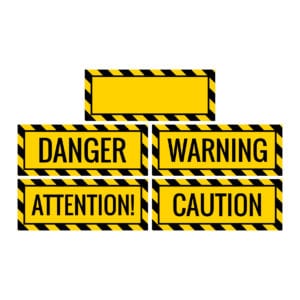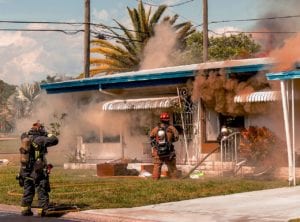
I recently had a situational awareness conversation with a firefighter who shared the details of an incident that made him both proud and disappointed. His company officer decided to do an exterior attack at a residential dwelling fire because the conditions had deteriorated to the point where an interior attack would not be warranted.
This decision was made even though neighbors were reporting there might be someone inside. Based on what I was told, the officer made the right call.
As it turns out, no one was inside and, if they were, the conditions were not compatible with life. This made the firefighter proud. But what happened next left him terribly disappointed.
 Apparently, the officer on the second-in engine did not share the same assessment of the conditions and had his crew pull a line and initiated an interior attack. That crew made no progress on putting the fire out or conducing anything close to an effective search. Within thirty seconds of entry they were “bailing out” of the house. The bailout crew commented about how quickly conditions deteriorated around them. These comments left the defensive crew absolutely stunned. The exterior crew saw the conditions as being untenable well before the aggressive crew even entered the structure.
Apparently, the officer on the second-in engine did not share the same assessment of the conditions and had his crew pull a line and initiated an interior attack. That crew made no progress on putting the fire out or conducing anything close to an effective search. Within thirty seconds of entry they were “bailing out” of the house. The bailout crew commented about how quickly conditions deteriorated around them. These comments left the defensive crew absolutely stunned. The exterior crew saw the conditions as being untenable well before the aggressive crew even entered the structure.
 The firefighter I interviewed described the interior crew as “hot dogs” who are always pushing the envelope of safety to the very limits and this time had a consequence as two members on the hot dog crew got burned… needlessly. So why did they enter an environment they should not have been in to begin with? Here are ten possible explanations to ponder:
The firefighter I interviewed described the interior crew as “hot dogs” who are always pushing the envelope of safety to the very limits and this time had a consequence as two members on the hot dog crew got burned… needlessly. So why did they enter an environment they should not have been in to begin with? Here are ten possible explanations to ponder:
- The officer on the crew that went interior suffers from low self-esteem and felt the need to justify their value to the organization and their fellow crew members by being overly aggressive.
- The officer on the crew that went interior has an over inflated ego and is of the mindset that “real” firefighters “always” conduct interior attacks, regardless of conditions.
- The officer on the crew that went interior arrived with a predisposed action in mind (aggressive offensive). With that mindset, no amount of clues or cues indicating that it would be a poor action choice is going to change their mind.
- The officer on the crew that went interior suffered from tunnel vision and did not complete a size-up that included the development of strong situational awareness.
- The other members on the crew that went interior were too afraid to speak up to their officer, even if they felt an aggressive interior attack was not appropriate.
- The other members on the crew that went interior did not know how to speak up to express their concerns to a superior officer.
- The officer on the crew that went interior had developed a habit of “always” conducting an aggressive interior attack. Habits are hard to break.
- The officer on the crew that went interior suffers from the “duty to die” syndrome and believes that it is one’s “sworn duty” to be in those conditions and if they dies while doing their job, that is a noble way to die.
- The officer on the crew that went interior has fought many interior fires that they believe were as bad as this one, or worse, and it always turned out okay (ie: no injuries).
- The officer on the crew that was defensive – who was the first arriving officer and designated incident commander – did not stand up to the rogue officer and forbid the interior attack. The officer on the exterior stood by and let it happen. They lacked a strong command presence.
Dr. Gasaway’s Advice:
 When you have an event similar to the one described above it is important to learn from it. Oftentimes nothing is said. Sometimes the aggressive interior crew is lauded for their heroic actions. That results in positive reinforcement for undesirable behaviors. Sometimes the crew who chooses to be defensive may be admonished for not being aggressive enough. That results in negative reinforcement of desired behaviors. (I’ll write a separate article about behavior reinforcement soon.)
When you have an event similar to the one described above it is important to learn from it. Oftentimes nothing is said. Sometimes the aggressive interior crew is lauded for their heroic actions. That results in positive reinforcement for undesirable behaviors. Sometimes the crew who chooses to be defensive may be admonished for not being aggressive enough. That results in negative reinforcement of desired behaviors. (I’ll write a separate article about behavior reinforcement soon.)
While these are ten possible explanations, without being at the scene or knowing any of the members of this department, it is virtually impossible for me to know for sure why this happened. But tough questions need to be asked and the core issue for unsafe behaviors needs to be addressed.
NOTE: The sad part of this story is the officer who made the decision to conduct an aggressive interior attack was not among the injured firefighters.
Action Items
 1. Have you ever been in a situation where your officer made a decision to be aggressive offensive under conditions that were untenable? How did you handle it?
1. Have you ever been in a situation where your officer made a decision to be aggressive offensive under conditions that were untenable? How did you handle it?
2. Why do you think it made sense to the interior officer to conduct aggressive interior operations under such rapidly deteriorating conditions?
3. What are your thoughts about the strength of the situational awareness of the two officers in this story? Why was there such a difference?
4. What can you do to reduce the possibility that you’ll ever be in this situation?
About the Author
Richard B. Gasaway, PhD, CSP is widely considered a trusted authority on human factors, situational awareness and the high-risk decision making processes used in high-stress, high consequence work environments. He served 33 years on the front lines as a firefighter, EMT-Paramedic, company officer, training officer, fire chief and emergency incident commander. His doctoral research included the study of cognitive neuroscience to understand how human factors flaw situational awareness and impact high-risk decision making.
_____________________________________________________

If you are interested in taking your understanding of situational awareness and high-risk decision making to a higher level, check out the Situational Awareness Matters Online Academy.
CLICK HERE for details, enrollment options and pricing.
__________________________________
Share your comments on this article in the “Leave a Reply” box below. If you want to send me incident pictures, videos or have an idea you’d like me to research and write about, contact me. I really enjoy getting feedback and supportive messages from fellow first responders. It gives me the energy to work harder for you.
Let’s Get connected
Facebook: SAMatters
LinkedIn: Rich Gasaway
LinkedIn: Situational Awareness Matters
Twitter: Rich Gasaway
Youtube: SAMattersTV
itunes: SAMatters Radio
Stitcher Radio: SAMatters Radio
Google Play: SAMatters Radio
iHeart Radio: SAMatters Radio

1. Yes, but I was brought up in the day where you didn’t question your officer’s decisions. We went in and tried to make a stop. Sometimes we were lucky and sometimes we pulled out.
2. Hard to say why, but I would guess to try and make the other officer look bad.
3. Sounds like the 2nd due didn’t do a lap or converse with the incident commander.
4. If I were the 1st in company I would make sure that it wouldn’t happen. If it did, sound the evacuation tones.
Our department has strong policies that if the call is for a defensive attack then no one goes inside. If you disobey an order you will be severely reprimanded. Possible demotion if a severe enough offense. In this day and age this type of behavior should not happen or be tolerated.
Larry,
Thanks for sharing your perspective. Like you, I was brought up in a fire department where we did not question the orders given by our superiors… as if to imagine that whatever decision they made… was ALWAYS going to be right and in the best interest of our safety.
As I look back, some of the officers I worked for early in my tenure were volunteers officers, elected because they were popular, not necessarily because they were qualified commanders. I never publicly questioned their orders. But I do recall a number of times when I was doing something that was unsafe and I never… ever… spoke up.
I’m feel blessed to be lucky enough to be here to rant about it now. ~ Rich
I like your approach to the 10 possible reasons for the actions to occur as described. As a chief officer looking in from the outside, with the limited information in the story, I see an issue with command and control of responding resources, as well as an organizational culture conflict.
1. Why do later arriving companies feel empowered to override the decisions of the (initial) incident commander?
2. Was the mode of operation identified and verbalized/transmitted for all incoming companies?
3. Was the crew moving into the interior instructed NOT to do so?
4. Does this department conduct post-incident reviews and seriously take away lessons learned?
5. Do they share those lessons with others in the organization regarding acceptable/unacceptable behaviors?
Rich, you are doing fantastic work. Thanks for engaging the profession to think about and discuss what we do and why we do it. If well heeded, your work will contribute to a safer and more effective fire service.
Chief DiBacco,
Thank you for the comment and sharing your observations. You ask great questions that reflect well on your experience and your command presence.
When I’ve been given the opportunity to come into a department and conduct a facilitated debriefing, we get answers to these questions. This particular example, unfortunately, did not come from a facilitated debrief so I don’t have the answers. I wish I did. It would add to the learning for all of us.
Thank you also, John, for the very kind comments about the site and my mission. My heart aches so much as I see firefighters dying in situations that could have been prevented. I see the headlines and watch the videos as these tragedies play out now in real-time on social media. I do not judge those involved. Instead, I try to help make sense of what happened by understanding why their actions made sense to them at the moment they were engaged in whatever it was that went wrong.
You’ve been a great friend over many, many years. I value your input so much. I know you’re getting amazing experience in your career command position. I hope you’ll share that often.
~ Rich
Rich, thank you for the work you’re doing, Great Stuff!
To your points:
1. Yes, I dug in and did what I was ordered. Fortunately it was during the time when our PPE would not allow deep penetration into the structure.
2-4. On the surface it appears that the two Officers have very different perspectives and levels of SA. It is very likely an issue of training/culture/attitude. Strategies and Tactics are not on many departments short list for training objectives; certainly not my department. In my department we have a two tiered Company Officer rank structure. A member must serve as a Lieutenant first then Captain. As a Captain I make it my responsibility to train my Lieutenants and FF’s to level of competency that far exceed what the department requires of them regarding SA and strategy & tactics. Your programs are very beneficial to me in that endeavor.
Our Chiefs use the Captain as Division Sups and the Captains use the Lieutenants as Team Leaders; strategic -tactic- task chain of command. Beyond that it’s a matter of personal command presence. We have our share of cowboys and hot dogs here. Without that command presence freelancing soon results. The culture here is evolving but it is a slow, very slow process.
Mike,
Thanks for the kind words about the website and my programs. I appreciate that VERY much. I am trying very hard to improve first responder situational awareness through science, not anecdotal stories and over-watched videos from YouTube. It’s hard for me to compete with some of the more “sexy” hands-on training topics, but improving situational awareness is part of the solution to improving firefighter safety. Alas, there are still too many cowboys and hotdogs (as you referred to them) out there that refuse to accept their cognitive vulnerabilities.
I appreciate your sharing your response to the discussion questions. It helps me push that heavy rock up the steep hill. Good to have you helping me.
Rich